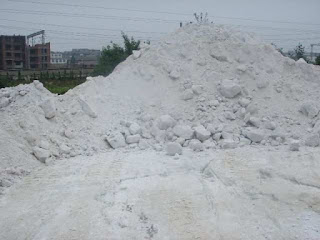Flotation reagents-fronther and modifiers
In flotation beneficiation plant, main euipments are important such as
ball mill, flotation machine, crushing machine etc. And the flotation reagents
are also important for flotation process, the reagents used in flotation are
usually divided into three classes:
Collectors: organic chemicals which make the
surface hydrophobic and hence the mineral is capable of being collected in the
process.
Frothers: organic chemicals which reduce
the surface tension of the water to stabilize the bubbles into a froth layer at
the top of the flotation cell to make concentrate removal easier.
Modifiers: organic or inorganic chemicals
used to modify the slurry conditions to enhance the difference in surface
chemistry between the valuable and gangue minerals.
Let’s introduce frothers and modifiers in this
article
Frothers
Frothers are surfactants, usually
organic heteropolar compounds such as alcohols or
polyglycol ethers. Due to the
heteropolar nature, the frother adsorbs at the air/water interface and as a
result, lowers the water surface tension. This has the effect of producing
smaller bubbles and more importantly it stabilises the froth when it reaches
the top of the slurry. If the bubbles burst when they reach the air/water
surface then any minerals they carry will drop back into the slurry forming a
scum at the surface. The prime role of the frother is to stabilise the froth
formed at the interface long enough for the concentrate to be removed from the flotation machine. Once removed from
the cell, the froth must break to allow the mineral particles to be re-pulped
for further processing.
The effect of frother concentration on
the surface tension of water is an initial rapid drop in
surface tension before leveling out to
a constant minimum value. The optimum frother
concentration is not the amount which
gives the minimum surface tension but in the region
where the surface tension is capable of
rapid change with concentration. This is the region of greatest froth
stability.
When the thin liquid film at the bubble
wall experiences an external stress and stretches
locally, the increase in surface area
produces a local decrease in surfactant concentration. This in turn increases
the surface tension momentarily to allow the thin film to recover without rupturing.
If there is no change in surface tension with local film thinning, for example
if the liquid is pure or the frother concentration is in excess then the froth
will be unstable. For excess frother concentration, all that will happen is the
formation of very small bubbles which burst on reaching the pulp surface.
Frothers commonly used include natural
chemicals like pine oil, cresylie acid
and synthetic reagents such as methyl
isabutyl carbinol (MIBC) and polyglycol
ethers. Ideally frothers should possess little or no collecting
properties and vice versa so that both functions can be controlled separately.
Modifiers
This class of reagents covers all
chemicals whose principal function is neither collecting nor frothing. These
may be further divided into depressants,
activators and pHregulators.
A depressant is any chemical which inhibits or prevents the adsorption of a
collector by a
mineral particle and thereby prevents
its flotation. An activator prepares the mineral surface to enhance the
adsorption of the collector. pH regulators adjust the pulp pH to give optimum performance
for a particular reagent and mineral ore. The common pH regulators are lime, soda
ash and sulphuric acid.
Other reagents that may be used in
specific cases include dispersants for
removing clay
slimes from mineral surfaces sxAprecipitants for removing
interfering ions from solution.
The main use of these modifying agents
is in the differential flotation of a mixed ore. That
is the successive removal of two or
more valuable minerals from each other by flotation. For example the separation
of each copper, lead, zinc and iron sulphides from a single ore is selective flotation whereas the
flotation of the combined sulphides from the gangue is referred to as bulk flotation.

评论
发表评论